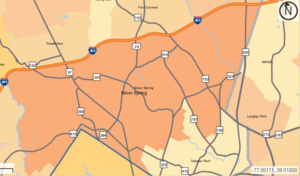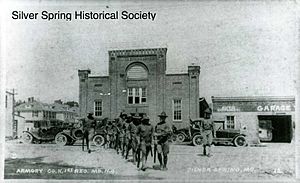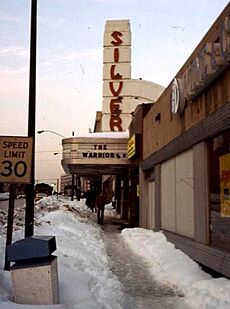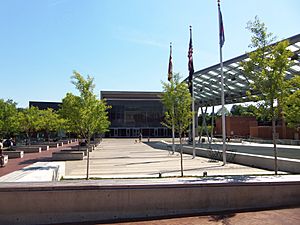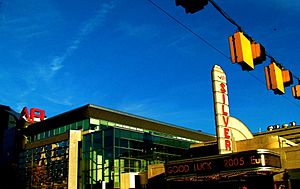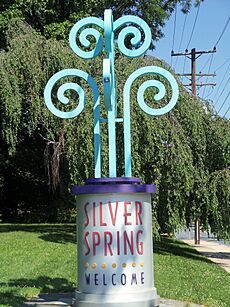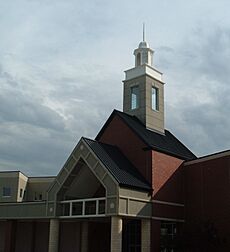Silver Spring, Maryland facts for kids
Quick facts for kids
Silver Spring, Maryland
|
|
|---|---|
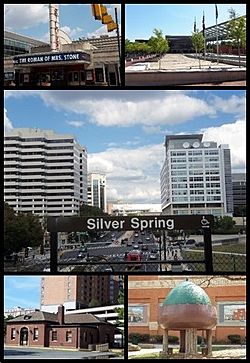
Clockwise from top: AFI Silver, Veteran's Plaza and the civic building, Downtown Silver Spring from the Metro station, Acorn Park, Baltimore and Ohio Railroad Station
|
|
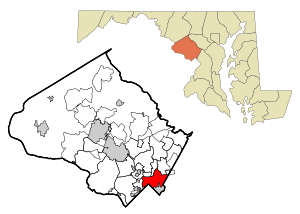
Location of Silver Spring in Montgomery County, Maryland (left) and of Montgomery County in Maryland (right)
|
|
| Country | United States |
| State | Maryland |
| County | Montgomery |
| Area | |
| • Total | 7.91 sq mi (20.49 km2) |
| • Land | 7.88 sq mi (20.42 km2) |
| • Water | 0.03 sq mi (0.08 km2) |
| Elevation | 272 ft (83 m) |
| Population
(2020)
|
|
| • Total | 81,015 |
| • Density | 10,277.18/sq mi (3,968.02/km2) |
| Time zone | UTC−05:00 (Eastern (EST)) |
| • Summer (DST) | UTC−04:00 (EDT) |
| ZIP Codes |
|
| Area codes | 301, 240 |
| FIPS code | 24-72450 |
| GNIS feature ID | 2390301 |
| Highways |
|
Silver Spring is a lively area in Montgomery County, Maryland, close to Washington, D.C.. Even though it's not officially a city, it's a big, busy place with over 81,000 people. This makes it one of the largest communities in Maryland.
Downtown Silver Spring is the oldest part of the area. It's right next to Washington, D.C. In recent years, many new buildings have been built here. These buildings often have shops, homes, and offices all in one place.
The name "Silver Spring" comes from a special spring found in 1840. This spring had shiny mica flakes in its water, making it look silver. Francis Preston Blair discovered it and bought a lot of land around it. Today, Acorn Park is thought to be where this original spring was located.
Contents
- Exploring Silver Spring's Location
- Parks and Outdoor Fun
- People and Population
- A Look Back at Silver Spring's History
- Culture and Fun Activities
- Getting Around Silver Spring
- Learning in Silver Spring
- Economy and Businesses
- Sports and Recreation
- Media and News
- Notable People from Silver Spring
- Images for kids
- See also
Exploring Silver Spring's Location
Silver Spring is a "census-designated place," which means its exact borders can change. The U.S. Census Bureau says it covers about 7.92 square miles (20.5 square kilometers) of land. Even though it's mostly land, there are some small creeks and ponds.
Neighborhoods and Wider Areas
Silver Spring includes many neighborhoods like Downtown Silver Spring, East Silver Spring, Woodside, and Long Branch.
The U.S. Postal Service uses a much larger area for Silver Spring mailing addresses. This "Greater Silver Spring" includes other communities like Wheaton, White Oak, and Colesville. This larger area is bigger than almost any other city in Maryland, except Baltimore.
Famous Spots in Silver Spring
Downtown Silver Spring has several cool landmarks. These include the AFI Silver Theatre, a branch of The Fillmore music venue, and the main office of the National Oceanic and Atmospheric Administration. In the wider Silver Spring area, you can find the headquarters of the Seventh-day Adventist Church and the Food and Drug Administration.
Parks and Outdoor Fun
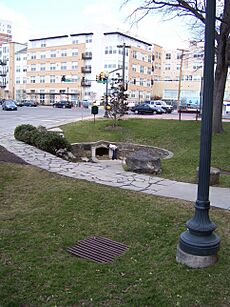
Silver Spring is home to four main creeks: Rock Creek, Sligo Creek, Long Branch, and Northwest Branch. All these creeks are surrounded by parks. These parks are great for hiking, playing, having picnics, and playing tennis. On weekends, some roads in the parks are closed so people can bike and walk safely.
Northwest Branch Park has the Rachel Carson Greenway Trail. It's named after Rachel Carson, who wrote the famous book Silent Spring. This trail goes all the way to Wheaton Regional Park, which has the beautiful 50-acre (20 ha) Brookside Gardens.
Jessup Blair Park, near downtown, is another great spot with a soccer field, tennis courts, and basketball courts. There are many other local parks throughout Silver Spring for everyone to enjoy.
People and Population
| Historical population | |||
|---|---|---|---|
| Census | Pop. | %± | |
| 1960 | 66,348 | — | |
| 1970 | 77,496 | 16.8% | |
| 1980 | 72,893 | −5.9% | |
| 1990 | 76,046 | 4.3% | |
| 2000 | 76,540 | 0.6% | |
| 2010 | 71,452 | −6.6% | |
| 2020 | 81,015 | 13.4% | |
| source: Note: land area of Silver Spring CDP reduced by 15% for 2010 census 2010–2020 |
|||
Silver Spring's Diverse Community
In 2020, about 81,015 people lived in Silver Spring. The community is very diverse, with people from many different backgrounds. About 50.9% of the population is female.
Many people in Silver Spring were born outside the United States. In 2019, about 36.5% of residents were born in other countries. Many of these residents come from El Salvador, Ethiopia, India, and China. This mix of cultures makes Silver Spring a very interesting place to live.
A Look Back at Silver Spring's History
Before Europeans arrived, Native American groups lived in the Silver Spring area for about 10,000 years. The Piscataway tribe may have had small villages along the creeks here.
How Silver Spring Began
In 1840, Francis Preston Blair and his daughter, Elizabeth, found a spring with shiny mica flakes. Blair was looking for a summer home away from the heat of Washington, D.C.. Two years later, he built a large house called "Silver Spring" on his 250-acre property. This house stood until 1954.
Blair's son, Montgomery Blair, also built a house in the area. He was an important figure who worked for Abraham Lincoln. Lincoln himself visited the Silver Spring mansion several times during the American Civil War.
In 1873, the Baltimore and Ohio Railroad opened a line through Silver Spring, connecting it to Washington, D.C. This helped the area grow. The first suburban homes were built in 1887.
Growth in the 20th Century
In the early 1900s, E. Brooke Lee helped develop Silver Spring. He built roads and neighborhoods. In 1924, the first high school, Takoma-Silver Spring High School, was built. It later became Montgomery Blair High School.
The Silver Spring Shopping Center and the Silver Theatre opened in 1938. The shopping center was one of the first to have parking right in front of the stores.
For a time, there were unfair rules that made it hard for certain groups of people to buy homes in Silver Spring. These rules were later made illegal.
By the 1950s, Silver Spring was a busy shopping area. But when a new shopping center, Wheaton Plaza, opened nearby in 1960, downtown Silver Spring started to decline.
The Capital Beltway (I-495) opened in segments in the early 1960s, making it easier to travel around the area. In 1978, the Washington Metro rail service came to Silver Spring, helping to bring new life to the area.
Silver Spring Today
In the early 2000s, downtown Silver Spring began to be redeveloped. New shops, restaurants, and entertainment venues were built. In 2003, Discovery Communications moved its headquarters to Silver Spring. The old Silver Theatre also reopened as AFI Silver, a popular movie theater.
This new development was so successful that a campaign called "silver sprung" was launched to show how much the area had improved. In 2007, The New York Times even wrote about Silver Spring's "renaissance."
In 2010, the Silver Spring Civic Building and Veterans Plaza opened, providing a new public space for events. The old City Place Mall was also renovated and reopened as Ellsworth Place.
Culture and Fun Activities
Downtown Silver Spring is a hub for entertainment and festivals. Each June, the Silverdocs documentary film festival takes place here. There's also an annual Thanksgiving Day Parade. The Silver Spring Jazz Festival is a big event in September, drawing thousands of people to enjoy free jazz music. Famous artists like Wynton Marsalis have performed there.
The Fillmore is a popular music venue that opened in 2011. It hosts many different artists and bands. The Cultural Arts Center at Montgomery College also offers various performances and lectures.
Silver Spring has a wide variety of restaurants, offering foods from all over the world, including American, Ethiopian, Japanese, Mexican, and Chinese cuisines.
The American Film Institute Silver Theatre and Culture Center shows American and foreign films. Silver Spring is also home to the National Oceanic and Atmospheric Administration (NOAA), which includes the National Weather Service.
Did you know that the famous singer Stevie Nicks of the band Fleetwood Mac was inspired by Silver Spring? She saw a sign for Silver Spring, Maryland, and it helped her write the band's 1977 song "Silver Springs"!
Getting Around Silver Spring
Major roads in Silver Spring include Georgia Avenue (MD 97) and Colesville Road (US 29). You can also access the Capital Beltway from these roads.
The Paul Sarbanes Transit Center in downtown Silver Spring is a very busy transportation hub. It serves the MARC Train, the Washington Metro Red Line at Silver Spring station, and many bus lines. This transit center helps nearly 60,000 passengers every day!
Soon, the Purple Line light rail will also serve the transit center. This new line will connect Silver Spring to Bethesda and the University of Maryland, College Park.
Learning in Silver Spring
Silver Spring is served by Montgomery County Public Schools.
High Schools
- James Hubert Blake High School
- John F. Kennedy High School
- Montgomery Blair High School
- Northwood High School
- Springbrook High School
- Wheaton High School
Montgomery Blair High School is especially known for its special programs in Communication Arts and Science, Mathematics, and Computer Science.
Middle Schools
- Benjamin Banneker Middle School
- Silver Spring International Middle School
- Takoma Park Middle School
- Eastern Middle School
- White Oak Middle School
- Briggs Chaney Middle School
- Argyle Middle School
- Odessa Shannon Middle School (previously Col. E. Brooke Lee Middle School)
- Sligo Middle School
- Francis Scott Key Middle School
- A. Mario Loiderman Middle School
- Thornton Friends Middle School
- Silver Creek Middle School
Private Schools
Some private schools in Silver Spring include The Siena School, Yeshiva of Greater Washington, and The Barrie School.
Colleges and Universities
A part of Montgomery College, the Takoma Park/Silver Spring campus, is located here. Howard University's School of Continuing Education also has a campus in Silver Spring.
Libraries
Silver Spring has several public libraries, including the Brigadier General Charles E. McGee Library in downtown Silver Spring. The Silver Spring Library, which started in 1931, is one of the most used libraries in Montgomery County.
Economy and Businesses
Many important companies and organizations have their main offices in Silver Spring. These include:
- American Nurses Association, a group for nurses
- CuriosityStream, a streaming video company
- Food and Drug Administration, a U.S. government agency that checks food and medicine
- Global Communities, a group that helps people around the world
- National Oceanic and Atmospheric Administration, a U.S. government agency that studies oceans and weather
- Urban One, a media company
- United Therapeutics, a company that works on new medicines
Sports and Recreation
The Silver Spring Saints Youth Football Organization has been a big part of youth sports since 1951. They play home games at St. Bernadette's Church.
Silver Spring also has many swim teams, including Parkland, Robin Hood, and Franklin Knolls.
The Silver Spring-Takoma Thunderbolts are a college baseball team that plays home games at Montgomery Blair Stadium. The Potomac Athletic Club Rugby team also has a youth rugby program in Silver Spring.
Media and News
Silver Spring is served by news outlets from the Washington metropolitan area, including The Washington Post newspaper. The Washington Hispanic newspaper also has its offices here.
Urban One, a media company, is headquartered in Silver Spring.
Notable People from Silver Spring
Many famous people have lived in or are from Silver Spring, including:
- Joe Alexander, basketball player
- Brady Anderson, baseball player
- Jonathan Banks, actor
- Carl Bernstein, journalist
- Lewis Black, comedian
- Rachel Carson, author of Silent Spring
- Dave Chappelle, comedian
- Connie Chung, news presenter
- Dominique Dawes, Olympic gymnast
- Michael Ealy, actor
- Steve Francis, former basketball player
- Goldie Hawn, actress
- Rian Johnson, film director
- Victor Oladipo, basketball player
- Nora Roberts, novelist
- Ben Stein, actor and commentator
- Rebecca Sugar, artist and director
Images for kids
See also
 In Spanish: Silver Spring (Maryland) para niños
In Spanish: Silver Spring (Maryland) para niños




